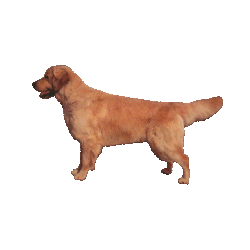
Anatomy and Physiology
A dog’s thyroid is made up of two elongated lobes connected by a narrow band known as the isthmus. These lobes are situated on the ventral surface of the neck, along the trachea, beginning just below the larynx and extending to approximately 4-5 cm below it.
The thyroid’s primary function is to produce hormones—triiodothyronine (T3) and thyroxine (T4)—that are responsible for regulating metabolism. Therefore, a deficiency of these hormones, which occurs in hypothyroidism, leads to the slowing down of various daily processes in the dog’s body. Energy and heat production, as well as the breakdown of proteins, fats, cholesterol, and other chemical substances, all take longer. T3 and T4 also influence heart function, maintaining the proper force and frequency of its contractions, and they stimulate erythropoiesis—the process of producing red blood cells.
Causes
Inherited hypothyroidism, occurring in approximately 7% of Golden Retrievers according to American studies, results from disruptions in the immune system. For unknown reasons, the dog’s body begins to produce anti-thyroglobulin antibodies (ATA or TgAA) from the first year of life onwards. These antibodies are directed against proteins found on the surface of thyroid cells. ATA circulate in the blood, and when they reach the thyroid, they immediately attach themselves to its cells. This signals the entire immune system that an enemy has appeared and should be destroyed. Consequently, these cells are rapidly destroyed (the same mechanism is activated when antibodies detect a virus, bacterium, etc.).
Day by day, thyroid cells are gradually killed off, and their number decreases continuously. However, like any organ, the thyroid has a functional reserve. This means that the number of cells a dog has from birth is 2-3 times greater than the body’s needs. Therefore, each cell produces only small amounts of hormones, never reaching 100% of its capacity. If some cells are destroyed, the remaining ones take over their functions and produce slightly more. Only the death of a very large number of cells (approximately 75%) leads to a situation in which the surviving cells are unable to meet the body’s demand for thyroid hormones. Hence, even though ATA are produced from the first year of life, hypothyroidism and its symptoms typically appear between the ages of 5-8. Of course, every organism is somewhat different in this regard, and there are dogs in which the hormone level decreases and symptoms appear much earlier. Why ATA are produced at all is still unknown. It is suspected that genetic predispositions play a role because it is more common in certain dog breeds (including Golden Retrievers).
Symptoms
The most common symptoms of hypothyroidism include:
Lethargy
Decreased temperament
Increased sensitivity to cold
Weight gain, obesity
Dermatological changes:
Bilateral symmetrical hair loss (typically on the sides of the body, chest, and armpits)
Pustular skin inflammation
Seborrhea
Dry and thickened skin prone to bacterial infections
Slowed heart rate, changes in EKG
Mild anemia
Elevated cholesterol levels in the blood serum
Diagnosis
Hypothyroidism is most commonly diagnosed based on clinical symptoms and blood tests—both general (morphology and biochemical analysis) and thyroid hormone levels (mainly T4). A general blood test is essential not only for providing information that can confirm the existence of hypothyroidism (e.g., elevated cholesterol levels, anemia) but also for ruling out other diseases such as diabetes or adrenal insufficiency. Thyroid hormone level tests can provide valuable information to the veterinarian, especially when combined with the dog’s overall condition, although they are subject to significant errors. This is due not only to the limited experience of veterinary laboratories in Poland (still regarding the determination of thyroid hormone levels) but also because thyroid hormone levels can change dramatically depending on the dog’s age, time of day, or temperature. In the USA and Western Europe, blood from dogs suspected of having hypothyroidism is also tested for the presence of ATA. This is a reasonably good indicator because these antibodies are present in about 60% of dogs with inherited hypothyroidism, often before hormone levels drop and disease symptoms become visible. Currently, there is no way to conduct such a test in Poland, but it is possible to send a properly prepared blood sample to Oxford Laboratories, Inc. in the USA.
Treatment
Treatment of hypothyroidism involves the administration of synthetic hormones—levothyroxine—as well as the treatment of complications such as bacterial skin infections. Hormone replacement therapy starts with a minimal dose of the drug, which is then adjusted based on treatment results. It is recommended to perform control tests for T4 levels approximately 2-3 months after starting treatment, and then based on the results of these tests. After establishing a stable drug dose, it is recommended to perform blood control tests every 1-2 years. It should be emphasized that the mere detection of ATA does not equate to hypothyroidism; it is only a signal to monitor hormone levels because the disease will almost certainly appear in the future.
Prevention
The only way to prevent inherited hypothyroidism in dogs is to perform regular blood tests on dogs intended for breeding. In the USA, tests for breeding dogs include screening for the presence of ATA as well as T4 and TSH (thyroid-stimulating hormone—secreted by the pituitary gland, stimulating the thyroid) hormone levels. Tests are conducted on dogs at the ages of 1, 2, 3, 4, 6, and 8 years. If ATA are detected in the blood, it is certain that hypothyroidism is inherited, and the dog must be excluded from breeding. If ATA are absent, but hormone levels are too low, it is considered idiopathic.
